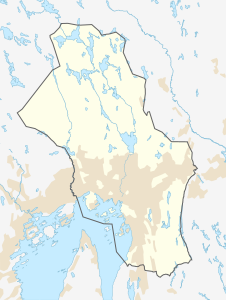Hovedøya
| Hovedøya | ||
|---|---|---|
| Waters | Oslofjord | |
| Geographical location | 59 ° 53 '42 " N , 10 ° 43' 45" E | |
|
|
||
| surface | 4.69 hectares | |
| Highest elevation | 50 m | |
Hovedøya or Hovedøen is an island in the Oslofjord not far from the city center of Oslo in Norway . A large part of the approximately 4.7 hectare island is a nature reserve, in which the highest elevation reaches almost 50 meters. In addition to several bathing areas, there is a large marina on the east side of the island . The island is connected to Oslo city center by a passenger ferry.
history
The oldest known building on the island was a church of unknown year of construction, dedicated to the Anglo-Saxon Saint St. Edmund . It is believed that the church served English traders passing through to Oslo. From 1147 to 1532 there was Hovedøya Monastery , a Cistercian monastery , the ruins of which have been preserved to this day. With the dissolution of the Norwegian monastery in the course of the Reformation , the Hovedøya monastery was also dissolved and burned down. Stones from the monastery were used, among other things, to expand Akershus fortress .
In the centuries that followed, the island repeatedly served as a strategically located cannon position or part of the city fortifications of Oslo. From 1872 to 1931 the island was a quarantine station for sick seafarers to keep them and their possibly contagious diseases away from the city of Oslo. During the Second World War , the German occupiers built a large barrack camp to quarter soldiers. After the war, an internment camp was set up in the barracks for women who maintained connections with the former enemy during the war. By April 1946, a total of around 1100 of these so-called Tyskertøsen were interned on the island. Until the early 1950s there were around 150 families on Hovedøya, where there was also a shop, post office and school. When the municipality bought the island from the Norwegian state for 4 million NOK in 1952 , the municipality had the barrack town demolished and dedicated Hovedøen to use as a recreational area .
nature
The entire island has been protected as Hovedøya Landskapsvernområde ( landscape protection area ) since 2006 . The largely undeveloped eastern and western parts of the island are also specially protected as nature reserves .
There is a particularly rich flora on the island, which benefits from the island's sheltered location in the Oslofjord and its calcareous soil. The island is home to the northernmost occurrences of mountain clover , pasque flower and Hartman's sedge , as well as rare plants such as the Nordic scorpionfish , mousetrap and Saxifraga osloensis (Oslo saxifrage ), which is only native to the Oslofjord . A total of 498 different vascular plants have been counted on the island since the beginning of the censuses around 1850 until today , 49 of which, however, are considered to have disappeared from the island.
gallery
Web links
Individual evidence
- ↑ a b Hovedøya , Visit Oslofjorden, accessed on June 5, 2020 (Norwegian)
- ↑ Klosteret på Hovedøya , Naturhistorisk Museum , University of Oslo , accessed on June 5, 2020 (Norwegian)
- ↑ Hovedøya landskapsvernområde Miljødirektoratet, accessed on June 5, 2020 (Norwegian)
- ↑ Forskrift om Verne Plan for Hovedøya - Østre Hovedøya naturreservat og Vestre Hovedøya naturreservat i Oslo commune, Oslo. , Lovdata.no, accessed June 5, 2020 (Norwegian)
- ↑ Planter på Hovedøya , Naturhistorisk Museum , University of Oslo , accessed on June 5, 2020 (Norwegian)
- ↑ Mangfold på Hovedøya Naturhistorisk Museum , University of Oslo , accessed on June 5, 2020 (Norwegian)
- ↑ Hovedøya , Norsk Botanisk Forening, accessed June 5, 2020 (Norwegian)






